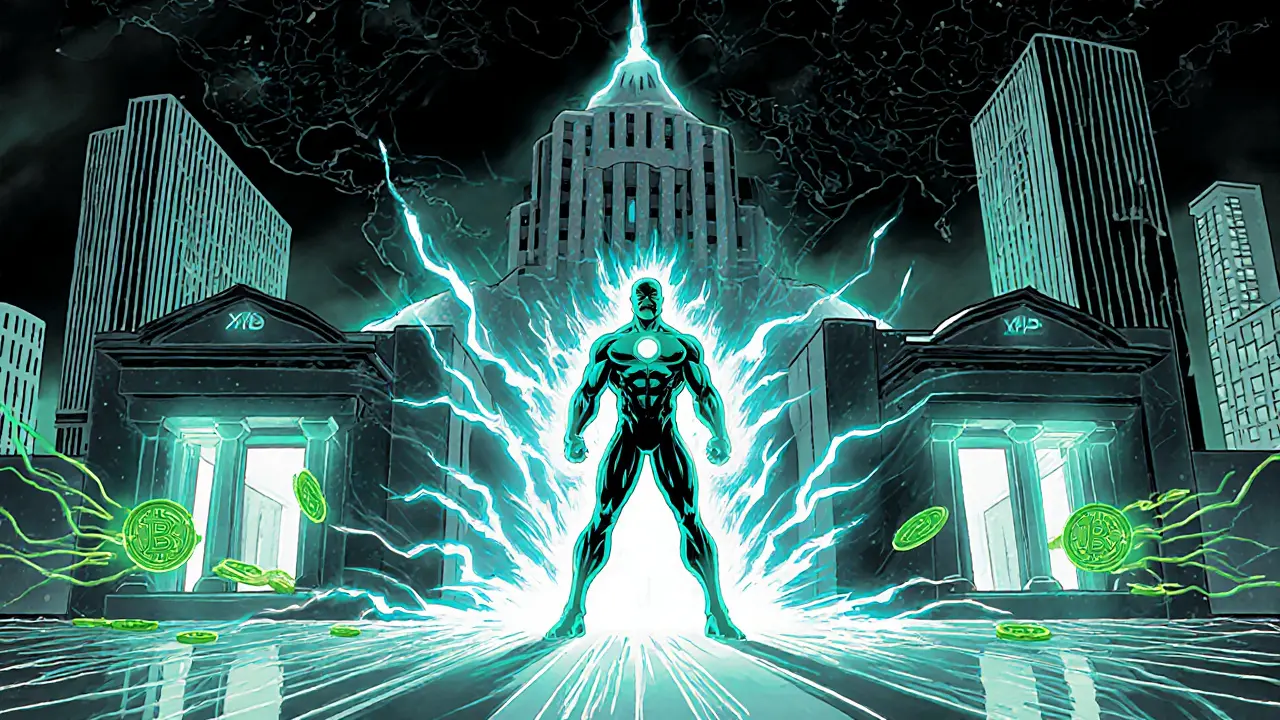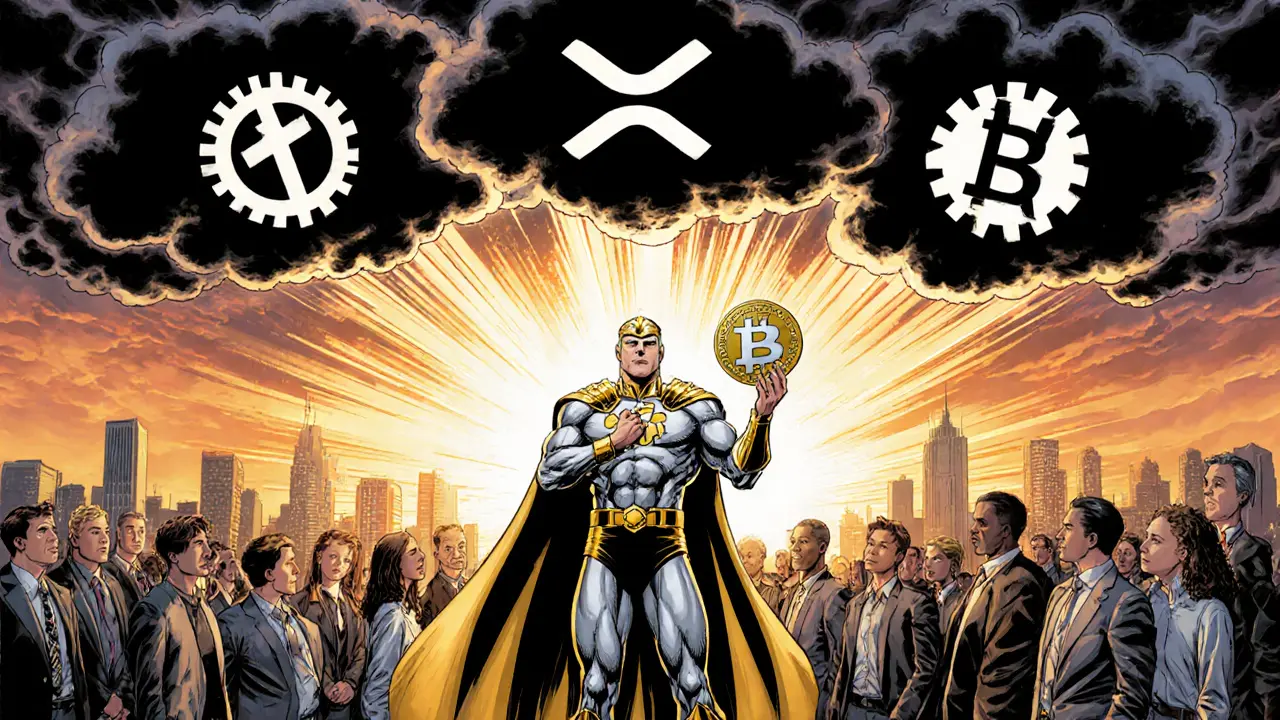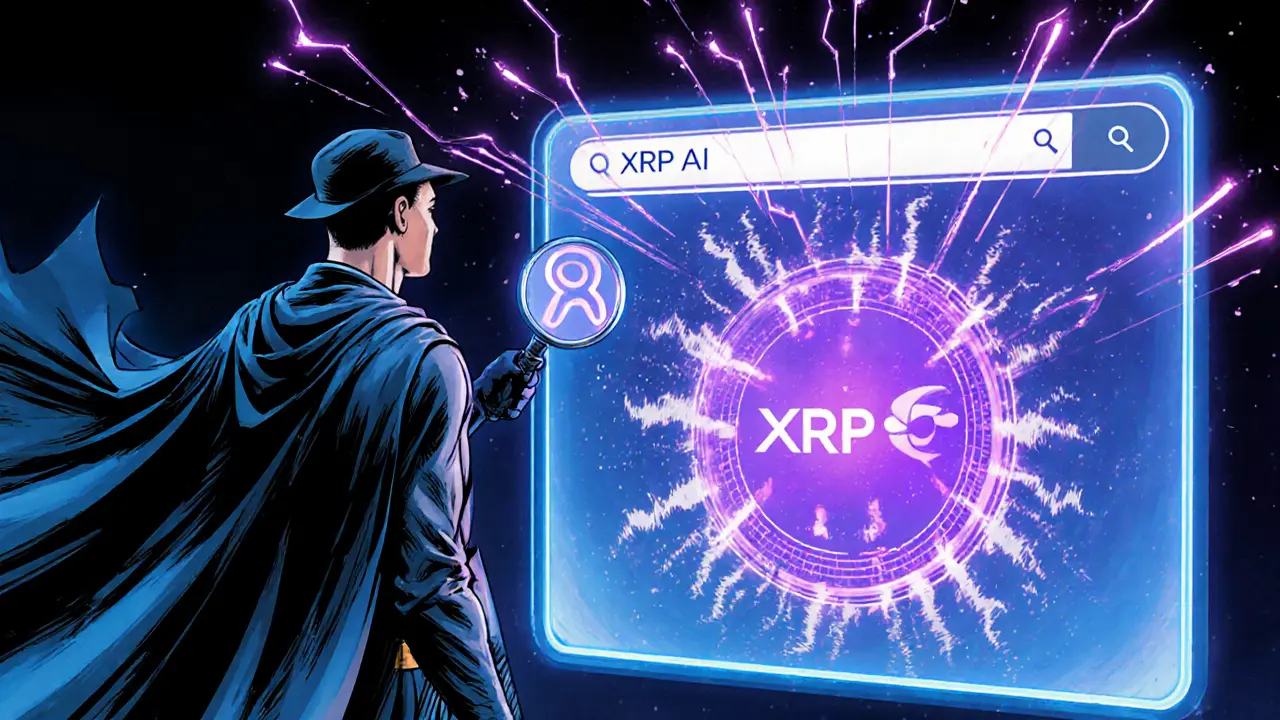XRP AI Misconception Checker
Is "XRP AI" a Real Cryptocurrency?
Enter a cryptocurrency name to check if it exists as a separate token or is a misnomer referring to Ripple's XRP.
Enter a cryptocurrency name above to check if it's a real token or a misnomer.
When you type XRP AI into a search box, the results usually pull up Ripple’s XRP token, not a separate AI‑powered coin. The short answer: there isn’t a dedicated “XRP AI” cryptocurrency. What does exist is the well‑known XRP token, its underlying ledger, and a wave of recent news that fuels the confusion. In this guide we’ll break down what XRP really is, why the AI label shows up, and what the latest 2025 developments mean for investors.
Key Takeaways
- "XRP AI" is not a distinct token; it’s a misnomer that points back to Ripple’s XRP.
- XRP runs on the XRP Ledger, a fast, low‑fee, consensus‑based network.
- Ripple’s settlement of the SEC lawsuit and pending ETF filings have reignited institutional interest.
- Price forecasts vary, but realistic targets stay under $5 for 2025; extreme $1,000‑plus scenarios ignore supply math.
- Investors should weigh fast transaction benefits against regulatory and centralization risks.
What Is XRP?
XRP is the native cryptocurrency of the XRP Ledger, created by Ripple Labs to enable quick, cheap cross‑border payments. It launched in 2012 and, as of October 2025, sits as the third‑largest crypto by market cap, valued around $3.00 per token with a market cap near $180billion.
The XRP Ledger and Its Technology
The XRP Ledger is a decentralized, public ledger that uses a unique consensus protocol instead of proof‑of‑work mining. This design lets the network settle transactions in 3-5 seconds with fees of a fraction of a cent, far cheaper than traditional SWIFT routes.
Because the ledger doesn’t rely on energy‑intensive mining, its carbon footprint is comparable to a small data center-not the massive consumption of Bitcoin. The consensus mechanism also means that the network can process around 1,500 transactions per second, enough for most global payment needs.
Ripple Labs and Real‑World Use Cases
Ripple Labs is the fintech company behind XRP and the On‑Demand Liquidity (ODL) platform. ODL uses XRP as a bridge currency, allowing banks and payment providers to settle cross‑border transfers instantly, bypassing the need for multiple correspondent banks and the associated liquidity costs.
Major institutions-including Santander, American Express, and Standard Chartered-have piloted ODL, reporting settlement‑time reductions from days to seconds and fee drops of up to 80%.

2025: Legal Clarity, Price Momentum, and ETF Hype
After a protracted battle with the U.S. Securities and Exchange Commission, Ripple resolved the lawsuit in early 2025 by paying a $125million settlement. The settlement lifted a major regulatory cloud, unlocking the door for broader institutional adoption.
Market data for October 2025 shows XRP trading around $3.00, a 27% rally year‑to‑date. Analysts note a 7.97% weekly gain and a 5.29% monthly rise. Technical models forecast a short‑term trading range of $2.95-$3.42, with a potential upside of 13% if ETF approvals materialize.
Eight XRP‑linked Exchange‑Traded Fund (ETF) applications are pending. If even one receives approval, estimates suggest $3-$5billion of institutional inflows, which could push the price toward $5 and, in an optimistic scenario, into the $7 range.
Is There an "XRP AI" Coin?
Extensive searches across major block explorers, token registries, and news outlets turn up zero evidence of a separate AI‑focused token named “XRPAI.” The phrase often appears in headline‑style articles attempting to capitalize on the buzz around AI, but it does not denote an officially registered cryptocurrency.
If a project later releases an AI‑enhanced layer on top of the XRP Ledger, it would likely be marketed under a different brand name rather than rebranding XRP itself. For now, treat “XRP AI” as a mislabel rather than a distinct investment.
How XRP Stacks Up Against Other Payment‑Focused Coins
| Attribute | XRP | Binance Coin (BNB) | Bitcoin (BTC) |
|---|---|---|---|
| Market Cap (USD) | $179B | $96B | $560B |
| Consensus Mechanism | Unique consensus (UNL) | Proof‑of‑Stake (PoS) | Proof‑of‑Work (PoW) |
| Transaction Speed | 3‑5seconds | ~3seconds | 10‑20minutes |
| Average Fee (USD) | $0.0002 | $0.01 | $15 |
| Primary Use Case | Cross‑border payments | Exchange utility & DeFi | Store of value |
The table highlights why XRP remains attractive for banks: lightning speed, negligible fees, and a focus on liquidity provision. BNB rivals XRP in speed but leans more toward exchange‑centric services, while Bitcoin’s strength lies in its brand as digital gold, not transaction efficiency.
Investment Considerations: Pros, Cons, and Realistic Expectations
Pros
- Fast settlement (seconds) and ultra‑low transaction costs.
- Growing institutional network through Ripple’s ODL partnerships.
- Regulatory clarity after the SEC settlement, paving the way for ETFs.
- Energy‑efficient consensus compared to PoW coins.
Cons
- Centralization concerns: Ripple Labs holds a large portion of the token supply and runs the validator list.
- Price volatility remains high; 2025 saw a swing from $3.07 to $1.77 in February.
- Dependence on Ripple’s business success; if ODL adoption stalls, demand could weaken.
- Regulatory risk persists in jurisdictions beyond the U.S., especially concerning stablecoin‑linked payments.
Mathematically, XRP’s 57billion circulating supply caps its upside. A $1,000 price would imply a market cap over $57trillion-far beyond global GDP. Realistic forecasts keep 2025 targets under $5 and 2030 averages near $24, according to industry analysts.
Frequently Asked Questions
Does an XRP AI token actually exist?
No. Searches for “XRP AI” currently point only to Ripple’s XRP token. There is no officially registered cryptocurrency called “XRP AI.”
How does XRP differ from Bitcoin?
XRP uses a consensus protocol that settles in seconds with near‑zero fees, while Bitcoin relies on proof‑of‑work, taking 10‑20 minutes per block and charging higher fees. XRP focuses on payments; Bitcoin is viewed as digital gold.
What impact does the SEC settlement have on XRP?
The $125million settlement removed a major legal cloud, allowing exchanges to list XRP more freely and opening the path for ETF filings, which could bring billions of institutional dollars into the market.
Can I expect XRP to reach $10 this year?
Most analysts project a high‑100‑dollar range for 2025, with $5-$7 as an optimistic ceiling if ETFs are approved. A $10 price would require a massive inflow and is considered unlikely by the majority of experts.
Is XRP suitable for long‑term holding?
If you value fast, low‑cost payments and believe Ripple will expand its institutional network, XRP can be a strategic long‑term play. However, be ready for price swings and consider diversification.

Next Steps for Interested Readers
If you’re curious about buying XRP, start by choosing a reputable exchange that lists the token (e.g., Binance, Coinbase). Verify that the platform complies with your local regulations. Keep an eye on ETF filing updates-these announcements often trigger sharp price moves.
For developers, the open‑source XRP Ledger offers APIs to build payment solutions without needing to hold large reserves of XRP. Experimenting with test‑net accounts is a low‑risk way to see how real‑time settlement works.
Finally, stay informed about Ripple’s partnership announcements and any regulatory changes in your jurisdiction. The crypto space evolves quickly; staying updated helps you make smarter decisions.


stephanie lauman
October 5, 2025 AT 09:31XRP AI is just a hype label, not a real token. 😊
Patrick MANCLIÈRE
October 6, 2025 AT 02:11Good to see the clarification-there’s no separate AI coin, it’s simply Ripple’s XRP being mislabeled. The ledger’s consensus model already handles high‑throughput payments efficiently. If developers want to add AI‑driven analytics, they would do it on top of the existing infrastructure, not by minting a new token.
Kortney Williams
October 6, 2025 AT 18:51Indeed, the allure of combining AI buzzwords with established crypto can mislead newcomers. While the XRP Ledger offers a robust API for smart contract‑like capabilities, any AI overlay would remain an application layer, not a sovereign currency. This distinction matters for investors who might otherwise chase phantom projects. Remember, utility derives from network adoption, not from clever naming. In philosophy terms, the label is an empty signifier without substance.
Laurie Kathiari
October 7, 2025 AT 11:31Let’s be clear: branding a known token with “AI” is a cheap marketing trick, and it obscures the real regulatory risks surrounding XRP. The SEC settlement still leaves questions about centralized control, and adding a hype veneer doesn’t absolve that.
Jim Griffiths
October 8, 2025 AT 04:11Correct, the settlement lifted a major cloud.
Matt Nguyen
October 8, 2025 AT 20:51Yo, everyone’s buying into the “XRPAI” hype like it’s some next‑gen miracle, but it’s just Ripple’s token with a fancy sticker-don’t be fooled by the shiny AI buzz.
Cynthia Rice
October 9, 2025 AT 13:31Another AI illusion, same old story.
Promise Usoh
October 10, 2025 AT 06:11The misnomer is a classic case of semantic drift, where “XRP AI” simply redirects to XRP’s ledger-no new token, no new code, just a naming confusion that’s been perpetuated across forums.
Taylor Gibbs
October 10, 2025 AT 22:51Exactly, the confusion stems from a lack of clear communication. If you’re looking to explore AI on top of the ledger, focus on the existing SDKs and data feeds rather than chasing a phantom coin. It’s all about building useful applications, not chasing branding gimmicks.
Scott McReynolds
October 11, 2025 AT 15:31Reading through the whole guide makes me appreciate how much noise surrounds crypto terms these days. First, the article correctly points out that “XRP AI” does not exist as a separate token, which is a relief for anyone worried about hidden scams. Second, the technical overview of the XRP Ledger’s consensus protocol is spot‑on; its low‑latency, low‑fee nature truly sets it apart from proof‑of‑work chains. Third, Ripple’s On‑Demand Liquidity platform has already shown real‑world adoption with banks like Santander, which underscores the network’s utility beyond speculative trading.
Fourth, the SEC settlement in early 2025 removed a massive regulatory cloud, and that event alone likely paved the way for more institutional confidence. Fifth, the article’s price forecasts are grounded in realistic supply math-no one expects $1,000 per token given the 57 billion supply. Sixth, the mentioned ETF applications could indeed usher in billions of new capital if even one receives approval.
Seventh, the comparison table with Bitcoin and Binance Coin nicely highlights XRP’s niche: ultra‑fast settlement and negligible fees. Eighth, the cons section is honest about centralization concerns-Ripple does hold a sizable stake, and that’s a genuine risk factor. Ninth, the article rightly warns about volatility; price swings from $1.77 to $3.07 within a year are not trivial.
Tenth, the environmental impact note is refreshing, showing XRP’s low carbon footprint versus PoW giants. Eleventh, the FAQs at the end address the most common misunderstandings succinctly. Twelfth, developers reading this should feel encouraged to experiment on the test‑net, as the guide suggests. Thirteenth, the emphasis on staying updated with regulatory changes is sound advice for any crypto participant.
Fourteenth, the piece balances optimism with caution, which is essential in today’s hype‑driven market. Fifteenth, the overall structure-starting with the misconception checker, moving through technology, use‑cases, and ending with actionable steps-makes it a valuable resource for both newcomers and seasoned traders alike. In short, while “XRP AI” is a mislabel, the underlying XRP ecosystem remains robust and worth watching.
Kimberly Kempken
October 12, 2025 AT 08:11People keep buying into the hype, thinking a new AI token will magically boost returns, when in reality it’s just the same old XRP with a fresh coat of paint.
Shaian Rawlins
October 13, 2025 AT 00:51The article does a solid job demystifying the “XRP AI” myth, and it’s helpful to see concrete data about transaction speeds and fees. It also highlights the real value proposition of XRP-fast, cheap cross‑border payments-rather than chasing speculative AI narratives. For anyone interested in building on the ledger, the open‑source APIs are a great place to start, and the test‑net offers a low‑risk environment for experimentation. Overall, staying grounded in the fundamentals is the best strategy.
Tyrone Tubero
October 13, 2025 AT 17:31Ah, the drama of “new AI token”-just a marketing stunt while the core tech does the real heavy lifting.
mukesh chy
October 14, 2025 AT 10:11Clearly the whole “XRP AI” hype is a conspiracy by marketers trying to ride the AI wave, but there’s no actual token, just clever SEO.
Amal Al.
October 15, 2025 AT 02:51Indeed, the lack of an official token confirms the speculation-there’s no separate blockchain, no distinct contract, just the existing XRP ledger being rebranded. Please check official registries for verification! 🙏
Alex Gatti
October 15, 2025 AT 19:31Nice summary of the facts.
Eva Lee
October 16, 2025 AT 12:11The post rightly calls out the misnomer, and it’s a good reminder to audit token registries before chasing buzzwords. Using precise terminology helps maintain market integrity.
Twinkle Shop
October 17, 2025 AT 04:51The distinction between an application layer employing AI analytics and a genuine AI‑native token is essential for developers. Without a dedicated token, any AI functionality must be built atop the XRP Ledger’s existing SDKs, which already provide high‑performance transaction processing. Investors should therefore evaluate the utility of such applications rather than be swayed by superficial naming conventions. In practice, the ledger’s consensus mechanism ensures deterministic finality, making it suitable for real‑time AI‑driven financial services. Ultimately, clarity in tokenomics prevents misallocation of capital and fosters sustainable growth.
Carthach Ó Maonaigh
October 17, 2025 AT 21:31Haha, another AI hype bubble burst-classic.
Greer Pitts
October 18, 2025 AT 14:11Appreciate the thorough breakdown; it’s helpful for anyone trying to separate fact from hype.
Jenise Williams-Green
October 19, 2025 AT 06:51While the article is balanced, one must remember the ethical dimension-branding a payment token with AI can mislead vulnerable investors, and that’s a moral issue we can’t ignore.
Adarsh Menon
October 19, 2025 AT 23:31Sure, “XRP AI” sounds cool, but it’s just a marketing gimmick.
Rob Watts
October 20, 2025 AT 16:11Overall, staying informed and focusing on actual utility is the best approach.